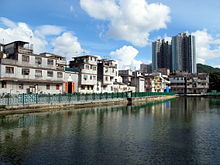Five Great Clans of the New Territories

| Five Great Clans of the New Territories | |||||||||||
|---|---|---|---|---|---|---|---|---|---|---|---|
| Chinese | 新界五大氏族 | ||||||||||
| |||||||||||
The Five Great Clans of the New Territories are the five families that settled before the seventeenth century and became sizeable in the New Territories of Hong Kong.
They are the Tang (鄧), Man (文), Hau (侯), Pang (彭) and Liu (廖).[1]
Tang
[edit]
Originated from Jishui of Jiangxi province, the Tangs were the first settled in the New Territories amongst the five clans, and were considered to be the first amongst all with the massive population and land. Tang Foo-hip migrated to now Kam Tin, Yuen Long in the early 11th century.[2] Two out of the five major branches remained in Hong Kong (Ping Shan and Kam Tin) while the other three moved back to mainland China. Descendants of Tang of Kam Tin further spread to Ha Tsuen, Tsz Tin Tsuen, Lung Yeuk Tau, Sha Tau Kok, Tai Po Tau, and other places.[3] Tangs also built ancestral and study halls, and markets near the villages, notably markets of Yuen Long and Tai Po, which were considered to have greatly contributed the development of New Territories.[4]
Man
[edit]
Man of San Tin had their ancestral root in Ji'an of Jiangxi. Man Tin-sui (文天瑞), the earliest traceable ancestor who is cousin of former Grand Chancellor Man Tin-cheung, fled to Dongguan during the late Southern Song dynasty. Man Sai-ko (文世歌), 7th general after Man Tin-sui, settled in San Tin during the era of Yongle Emperor's reign. At its peak, the Man Clan owned 40 million square feet of land in Lok Ma Chau.[5]
Liu
[edit]
Ancestors of Liu Clan initially resided in Yongding of Fujian. During the Yuan dynasty, Liu Chung-kit (廖仲傑) moved to Tuen Mun and Futian until his eventual stay near Sheung Yue River.[6] His son Liu Chi-yuk (廖自玉) founded the village of Sheung Shui Heung after the Kans left. According to myths, the Lius dressed up as ghosts to spook the Kans, forcing them to relocate to Tsung Pak Long. Nowadays Liu Clan would still thank the Khan during their rituals.[7] Majority of the Liu Clan still lived in Sheung Shui Wai, whilst some branches moved to Cheung Muk Tau and Ngau Pei Sha.
The Liu Clan, during Qing's rule, established Shek Wu Hui,[8] and brought tremendous fortune to the clan because of its proximity with Shenzhen market, overtaking the Hau Clan in the same region. The family owned land as far as So Kon Po on the Hong Kong Island.[9]
Hau
[edit]
The Hau Clan arrived in modern-day Hong Kong towards the end of the 12th century, during the Southern Song dynasty. They first settled at Ho Sheung Heung. They later settled three branch-villages: Yin Kong, Kam Tsin and Ping Kong.[1]
Hau Clan of Sheung Shui originated from Panyu of Guangdong. Hau Cheuk-fung (侯卓峰) later moved to Ho Sheung Heung,[10] with two sons relocating to Kam Tsin and other places. The then powerful clan formed two clans in Sheung Shui (near nowadays Hang Tau and Shek Wu Hui), but was eventually surpassed by the Liu Clan. Fanling Golf Course was built as a result of negotiation between the Hau Clan and the Hong Kong Government in 1908, which the former was compensated for the loss of ancestral land.[4]
Pang
[edit]
Pang Clan rooted in Yichun, Jiangxi until Pang Kwai (彭桂) and his family relocated to Lung Yeuk Tau of Fanling. In the late Yuan dynasty Pangs were forced out by the migrating Tangs and lived in Fan Leng Lau instead.[11] Offspring of Pang Clan also resided in Tsiu Keng, Ting Kok, So Kwun Po, and So Kon Po of Liu Clan's leased land.[12][13] In the late 1940s, Pang formed Luen Wo Hui with other nearby villages to challenge Tang's Shek Wu Hui.[14]
See also
[edit]References
[edit]Citations
[edit]- ^ a b Baker 1966, p. 26.
- ^ "口頭傳統和表現形式 - 宗族口述傳說(錦田鄧氏)". Archived from the original on 2019-09-17. Retrieved 2015-05-23.
- ^ "口頭傳統和表現形式 - 宗族口述傳說(龍躍頭鄧氏)". Archived from the original on 2019-08-24. Retrieved 2015-05-23.
- ^ a b "香港的先民宗族". Archived from the original on 2019-09-27. Retrieved 2015-05-19.
- ^ "新田文氏擁地2000萬呎 打游擊密集搜購發展商化零為整". Archived from the original on 2020-12-06. Retrieved 2020-11-28.
- ^ 口頭傳統和表現形式 - 宗族口述傳說(上水廖氏)[permanent dead link]
- ^ "鄭澄、梁浩宜、蔡俊傑:《香港新界上水廖氏春祭考察報告》" (PDF). Archived from the original (PDF) on 2017-08-18. Retrieved 2017-08-17.
- ^ "追溯香港人的根". Archived from the original on 2019-06-11. Retrieved 2015-05-23.
- ^ "白花油之香 飄過掃桿埔". HKEJ. 2016-01-04. Archived from the original on 2021-03-10. Retrieved 2017-03-07.
- ^ "口頭傳統和表現形式 - 宗族口述傳說(河上鄉侯氏)". Archived from the original on 2019-06-13. Retrieved 2015-05-23.
- ^ 《香港地區史研究之三:粉嶺》,陳國成主編,三聯書店(香港)出版,2006年
- ^ "口頭傳統和表現形式 - 宗族口述傳說(粉嶺彭氏)". Archived from the original on 2019-06-13. Retrieved 2015-05-23.
- ^ 《新安縣志》卷二十三<藝文>中所收錄由新安知縣段巘生於雍正二年(1724年)所寫的〈創建文岡書院社學社田記〉中有記載此事。
- ^ "聯和墟市說粉嶺". Archived from the original on 2019-07-02. Retrieved 2015-05-23.
Sources
[edit]- Baker, Hugh D. R. (1966). "The Five Great Clans of the New Territories" (PDF). Journal of the Hong Kong Branch of the Royal Asiatic Society. 6: 25–48. JSTOR 23881432.
